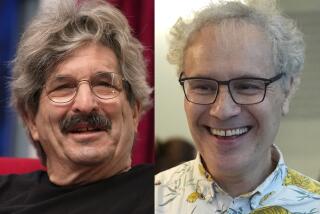2 Americans and Briton Get Nobel Medicine Prize
Two Americans and a Briton shared the 1988 Nobel Prize for Medicine on Monday for research that produced sharp changes in the way new therapeutic drugs are developed.
The work of the three researchers led to drugs now used against a wide range of illnesses, including AIDS, heart disease and peptic ulcers. They were among the first to design drugs on the basis of a biochemical understanding of the underlying disease process.
Gertrude B. Elion and George H. Hitchings of Burroughs Wellcome Co. in Research Triangle Park, N.C., exploited differences in the biochemistry of cancer cells, viruses and human cells to develop the first useful drugs against leukemia and herpes. They also laid the groundwork for the research that produced AZT, the only drug now approved for use against acquired immune deficiency syndrome.
Discovered Beta-Blockers
James W. Black of King’s College in London recognized the importance of receptors on the surface of cells in the central nervous system. Searching for chemicals that would shut down these receptors, he discovered the family of heart drugs known as beta-blockers, which are now used by more than 5 million people, and the anti-ulcer drug Tagamet, which in 1986 became the first drug to have more than $1 billion per year in sales.
Before Elion, 70, and Hitchings, 83, began their work in the 1940s, new drugs were developed largely on a hit-and-miss basis by screening plant and bacterial extracts for biological activity and by chemically modifying existing drugs, the Nobel citation from Stockholm’s Karolinska Institute said.
This approach was successful for the development of antibiotics because the metabolism of the targeted bacteria is sufficiently different from that of humans that drugs that killed bacteria were unlikely to harm humans.
Similar Metabolisms
But the metabolism of viruses and cancer cells is very similar to that of humans, so there is little margin for error in developing anti-cancer drugs that would not kill healthy cells.
Elion and Hitchings thus began seeking subtle differences between cancer cells and healthy cells that could be used for a chemical attack. They focused on the synthesis of ribonucleic acids, the individual molecules that become part of deoxyribonucleic acids (DNA), the genetic blueprint of life.
They discovered that a chemical, 6-mercaptopurine, blocked the synthesis of ribonucleic acids in cancer cells but had no effect on healthy cells. In the early 1950s, it became the first drug successfully used against childhood leukemia.
At that time, the life expectancy of children with the disease was about three months. Today, because of 6-mercaptopurine and other drugs developed in the same fashion, more than 80% of leukemia victims are cured.
Broad Effect on Research
“Their work influenced the way a whole generation of physicians and researchers went about developing drugs,” said Samuel Broder of the National Cancer Institute in Washington.
Hitchings said Monday that the success of the drug meant more to him than the Nobel award. “The thrill for me is meeting individuals whose lives have been saved by something I’ve done,” he said at a news conference.
Elion agreed. “There’s nothing that gives you a lift like seeing somebody get better from a serious disease,” she said. “The Nobel is something that is going to disappear in a few days. But the other (seeing patients recover) is permanent.”
Spurred Many New Drugs
Hitchings’ and Elion’s work has led to the development of a long series of drugs, including: acyclovir, the first drug effective against a virus, which is used to combat herpes; azathioprine, the first drug useful for preventing rejection of transplanted organs; allopurinol, a treatment for gout; pyrimethamine, which is used against malaria, and AZT.
“We are still harvesting the fruits of what they determined almost 40 years ago,” said Folke Sjoquist, a member of the Nobel Assembly that selected the awardees.
Black, 64, was working for Britain’s Imperial Chemical Industries Ltd. in 1964 when he discovered that a drug called propanolol could block the binding of the stimulant epinephrine to the so-called beta receptors on the surface of cells in the central nervous system. Epinephrine causes such effects as an increase in the speed and force of heartbeats.
Propanolol is now widely used to reduce blood pressure, ease the pain of angina and minimize the damage resulting from heart attacks. Its discovery made ICI a major drug company.
Greatest Since Digitalis
Physiologist Bengt Pernow, another member of the Nobel Assembly, called the discovery of propanolol “the greatest breakthrough (in the treatment of heart disease) since the discovery of digitalis 200 years ago.”
Black then joined the American firm SmithKline Beckman, where in 1972 he discovered histamine receptors that are crucial to the development of ulcers. He developed the drug cimetidine, trade-named Tagamet, which blocked the receptors and healed the ulcers. It is now the best-selling prescription drug in the United States.
The three researchers will receive the $393,000 prize and individual gold medals in a ceremony in Stockholm on Dec. 10.
More to Read
Sign up for Essential California
The most important California stories and recommendations in your inbox every morning.
You may occasionally receive promotional content from the Los Angeles Times.










